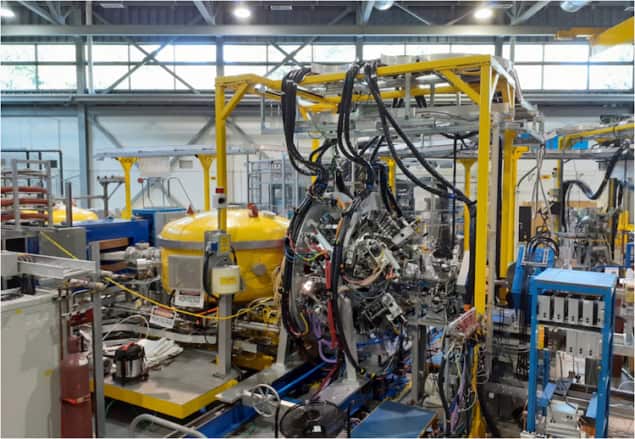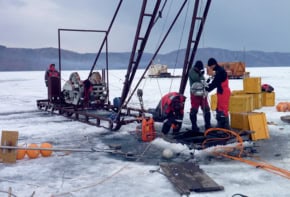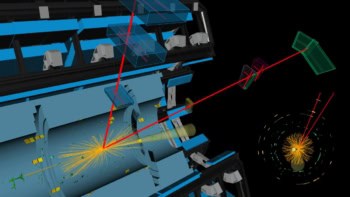
New measurements by physicists from the University of Surrey in the UK have shed fresh light on where the universe’s heavy elements come from. The measurements, which were made by smashing high-energy protons into a uranium target to generate strontium ions, then accelerating these ions towards a second, helium-filled target, might also help improve nuclear reactors.
The origin of the elements that follow iron in the periodic table is one of the biggest mysteries in nuclear astrophysics. As Surrey’s Matthew Williams explains, the standard picture is that these elements were formed when other elements captured neutrons, then underwent beta decay. The two ways this can happen are known as the rapid (r) and slow (s) processes.
The s-process occurs in the cores of stars and is relatively well understood. The r-process is comparatively mysterious. It occurs during violent astrophysical events such as certain types of supernovae and neutron star mergers that create an abundance of free neutrons. In these neutron-rich environments, atomic nuclei essentially capture neutrons before the neutrons can turn into protons via beta-minus decay, which occurs when a neutron emits an electron and an antineutrino.
From the night sky to the laboratory
One way of studying the r-process is to observe older stars. “Studies on heavy element abundance patterns in extremely old stars provide important clues here because these stars formed at times too early for the s-process to have made a significant contribution,” Williams explains. “This means that the heavy element pattern in these old stars may have been preserved from material ejected by prior extreme supernovae or neutron star merger events, in which the r-process is thought to happen.”
Recent observations of this type have revealed that the r-process is not necessarily a single scenario with a single abundance pattern. It may also have a “weak” component that is responsible for making elements with atomic numbers ranging from 37 (rubidium) to 47 (silver), without getting all the way up to the heaviest elements such as gold (atomic number 79) or actinides like thorium (90) and uranium (92).
This weak r-process could occur in a variety of situations, Williams explains. One scenario involves radioactive isotopes (that is, those with a few more neutrons than their stable counterparts) forming in hot neutrino-driven winds streaming from supernovae. This “flow” of nucleosynthesis towards higher neutron numbers is caused by processes known as (alpha,n) reactions, which occur when a radioactive isotope fuses with a helium nucleus and spits out a neutron. “These reactions impact the final abundance pattern before the neutron flux dissipates and the radioactive nuclei decay back to stability,” Williams says. “So, to match predicted patterns to what is observed, we need to know how fast the (alpha,n) reactions are on radioactive isotopes a few neutrons away from stability.”
The 94Sr(alpha,n)97Zr reaction
To obtain this information, Williams and colleagues studied a reaction in which radioactive strontium-94 absorbs an alpha particle (a helium nucleus), then emits a neutron and transforms into zirconium-97. To produce the radioactive 94Sr beam, they fired high-energy protons at a uranium target at TRIUMF, the Canadian national accelerator centre. Using lasers, they selectively ionized and extracted strontium from the resulting debris before filtering out 94Sr ions with a magnetic spectrometer.
The team then accelerated a beam of these 94Sr ions to energies representative of collisions that would happen when a massive star explodes as a supernova. Finally, they directed the beam onto a nanomaterial target made of a silicon thin film containing billions of small nanobubbles of helium. This target was made by researchers at the Materials Science Institute of Seville (CSIC) in Spain.
“This thin film crams far more helium into a small target foil than previous techniques allowed, thereby enabling the measurement of helium burning reactions with radioactive beams that characterize the weak r-process,” Williams explains.
To identify the 94Sr(alpha,n)97Zr reactions, the researchers used a mass spectrometer to select for 97Zr while simultaneously using an array of gamma-ray detectors around the target to look for the gamma rays it emits. When they saw both a heavy ion with an atomic mass of 97 and a 97Zr gamma ray, they knew they had identified the reaction of interest. In doing so, Williams says, they were able to measure the probability that this reaction occurs at the energies and temperatures present in supernovae.

Photon collisions in dying stars could create neutrons for heavy elements
Williams thinks that scientists should be able to measure many more weak r-process reactions using this technology. This should help them constrain where the weak r-process comes from. “Does it happen in supernovae winds? Or can it happen in a component of ejected material from neutron star mergers?” he asks.
As well as shedding light on the origins of heavy elements, the team’s findings might also help us better understand how materials respond to the high radiation environments in nuclear reactors. “By updating models of how readily nuclei react, especially radioactive nuclei, we can design components for these reactors that will operate and last longer before needing to be replaced,” Williams says.
The work is detailed in Physical Review Letters.



